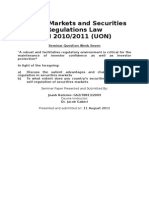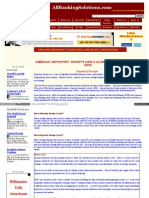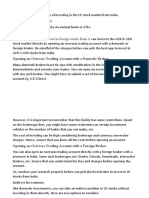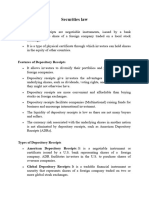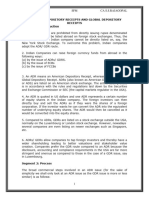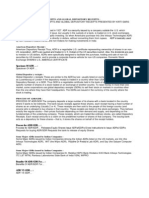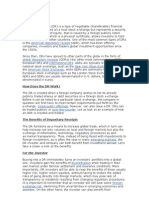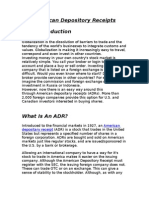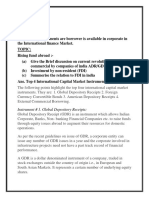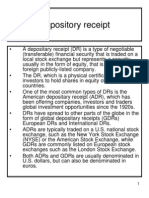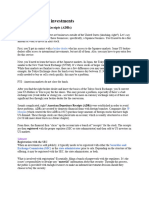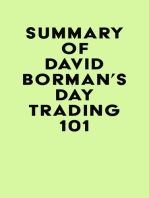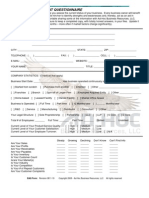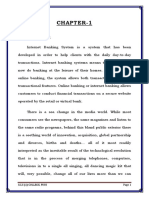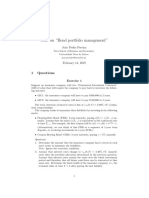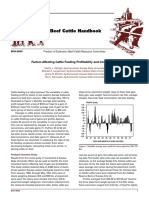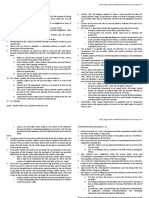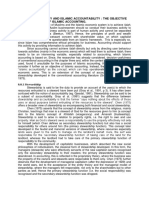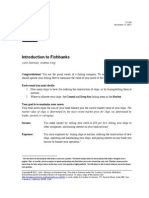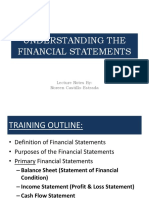0 ratings0% found this document useful (0 votes)
119 viewsHow ADRs Work
How ADRs Work
Uploaded by
Pallavi WaghThe document discusses what ADRs and GDRs are, how they work, and how investors can purchase them. ADRs and GDRs allow foreign companies to list shares on an exchange outside their home country. They are issued by a depositary bank which holds the underlying shares of the foreign company on behalf of ADR/GDR owners. There are different types of ADRs with varying reporting requirements depending on which US exchange they trade on.
Copyright:
© All Rights Reserved
Available Formats
Download as DOCX, PDF, TXT or read online from Scribd
How ADRs Work
How ADRs Work
Uploaded by
Pallavi Wagh0 ratings0% found this document useful (0 votes)
119 views9 pagesThe document discusses what ADRs and GDRs are, how they work, and how investors can purchase them. ADRs and GDRs allow foreign companies to list shares on an exchange outside their home country. They are issued by a depositary bank which holds the underlying shares of the foreign company on behalf of ADR/GDR owners. There are different types of ADRs with varying reporting requirements depending on which US exchange they trade on.
Original Description:
adr work
Copyright
© © All Rights Reserved
Available Formats
DOCX, PDF, TXT or read online from Scribd
Share this document
Did you find this document useful?
Is this content inappropriate?
The document discusses what ADRs and GDRs are, how they work, and how investors can purchase them. ADRs and GDRs allow foreign companies to list shares on an exchange outside their home country. They are issued by a depositary bank which holds the underlying shares of the foreign company on behalf of ADR/GDR owners. There are different types of ADRs with varying reporting requirements depending on which US exchange they trade on.
Copyright:
© All Rights Reserved
Available Formats
Download as DOCX, PDF, TXT or read online from Scribd
Download as docx, pdf, or txt
0 ratings0% found this document useful (0 votes)
119 views9 pagesHow ADRs Work
How ADRs Work
Uploaded by
Pallavi WaghThe document discusses what ADRs and GDRs are, how they work, and how investors can purchase them. ADRs and GDRs allow foreign companies to list shares on an exchange outside their home country. They are issued by a depositary bank which holds the underlying shares of the foreign company on behalf of ADR/GDR owners. There are different types of ADRs with varying reporting requirements depending on which US exchange they trade on.
Copyright:
© All Rights Reserved
Available Formats
Download as DOCX, PDF, TXT or read online from Scribd
Download as docx, pdf, or txt
You are on page 1of 9
How ADRs work
For a real example, lets look at ICICI Bank. This
stock is listed in India and isnt available to most
foreign investors.
However it has a depositary receipt issued in New
York and traded on the New York stock exchange,
which almost anyone can buy.
The depositary receipt for ICICI is issued by
Deutsche Bank. For each depositary receipt in
circulation, Deutsche Bank holds the equivalent
number of India-listed shares on behalf of the
owners of the ADR.
One ADR or GDR does not always equal one share
of underlying stock. And with ICICI, the ADR
actually represents two India-listed shares of ICICI
and is priced accordingly.
This is quite common and is done so that the price
of the ADR is typical for the market where it trades.
Very low-priced shares may have each depositary
receipt backed by several shares
For very high-priced ones, each depositary receipt
represents a fractional claim on the underlying
shares. For example, each Nintendo ADR in the
US is worth one-eighth of a Nintendo share in
Tokyo.
The price of the depositary receipt should be equal
to the price of the underlying shares, adjusted for
currencies. Thats because major institutional
investors can arbitrage between the price of the
underlying share and the price of the ADR/GDR if
the relationship moves too far out of line.
However, in some special cases this may not be
true for example, in cases where countries put
limits on the maximum amount of a companys
shares that can be owned by foreign investors.
If that limit has already been reached, the ADR
may trade at a persistent premium to the value of
the underlying shares because its the only way
that foreign buyers can buy into that company. One
persistent example of this is HDFC Bank, another
Indian bank with an ADR in New York.
The depositary bank that issues the ADR can
charge a fee for the costs of holding on to the
shares that back the ADR and doing all the
paperwork. This is typically around US$0.01-0.03
per share per year.
Where the company pays dividends, this will
usually be deducted from the dividend before that
is paid on to the ADR holder. Where the company
does not pay a dividend, the depositary bank will
usually charge your broker who holds the ADRs on
your behalf. The broker will then usually pass those
fees onto you.
Sponsored versus
unsponsored ADRs
The US allows several different types of ADR. Its
important to know the difference, since they have
different degrees of backing and support from the
company you are investing in.
Unsponsored ADRs are issued without a formal
agreement between the issuing bank and the
foreign company indeed, the company may have
no desire to see its shares listed abroad at all. They
trade on the over-the-counter market.
Sponsored ADRs fall into three categories. All are
supported by the company, but with different levels
of regulation.
Level I ADRs trade in the over the counter market.
Reporting requirements are very low the
company does not need to issue any reports in the
US or under US accounting standards. It must be
listed on a foreign stock exchange and issue a
report in English in that country under local
accounting rules.
Level II ADRs can trade on a stockmarket such as
NYSE or Nasdaq. The company must register with
the Securities and Exchange Commission and
issue annual reports in the US to US accounting
standards.
Level III ADRs are used by companies that dont
simply want to float their shares abroad, but also to
raise capital in the US market. Consequently, they
are regulated to a similar standard to US
companies. They must issue a offering prospectus,
while all subsequent new releases made in their
home market must also be issued in the US to US
standards.
However, bear in mind that just because a
company officially complies with US regulations, it
does not mean that it as strongly regulated or as
transparent as you might expect from a developedmarket company. And the fact that a well-known
accounting firm has signed off on the accounts is
no guarantee that they are accurate, as many
scandals have demonstrated.
The distinction between unsponsored and
sponsored depositary receipts exists for markets
outside the US. For example, in Germany a foreign
companys shares may be listed on the BerlinBremen exchange without its consent. The
classification of sponsored ADRs into three levels
is specific to US regulatory system.
How to buy ADRs and
GDRs
You should be able to buy major ADRs and GDRs
listed in your local market through your usual stock
broker. There are stock brokers that wont deal in
any, but thats unusual these days. However,
especially with GDRs, not all discount brokers will
offer less popular stocks, so in some cases you
may need to call around to find a broker that will
carry out the trade.
If youre looking to see what ADRs and GDRs are
available worldwide, you could search the listings
in your local exchange or check the websites of
any foreign companies that interest you.
But a more convenient resource is the depositary
receipt directory maintained by BNY Mellon, one of
the big global depositary banks. This allows you to
search for depositary receipts by country, company
and place of listing.
However, not all ADRs and GDRs listed here are
tradable by retail investors. In particular, there is an
option in US securities law to issue shares that are
intended only for certain investors and these are
sometimes used for ADRs.
Rule 144-A shares are specifically only to be traded
by institutions. Regulation S shares cannot be
traded by any US person and are intended for nonUS residents in practice many are tradable by
institutions only as well. (One popular trick among
stock scammers and boiler rooms is to sell unwary
investors Regulation S shares that have no active
retail market and will be impossible to sell at
anything except a knockdown price.)
The result is that many ADRs and GDRs are not
listed on any stock exchange, are highly illiquid or
are only traded in large blocks by institutions. So
the amount of depositary receipts that are listed,
liquid and tradable by retail investors is
considerably less than the total outstanding stock
of ADRs and GDRs.
In addition, investors should take great care when
investing in unsponsored depositary receipts or any
kind of unauthorised secondary listing of a foreign
company. The liquidity of these instruments is often
very poor and it has no official backing from the
company.
Whats more, the ADR could be withdrawn at any
time and you could be waiting for some
considerable time before the depositary sells the
shares and sends you the proceeds. And you may
be hit with an unreasonably large administration
fee in the process. While a sponsored ADR can
also be withdrawn, it will typically be done in a
more shareholder-friendly way than with an
unsponsored ADR.
Hence, even though a stock may have an ADR or
GDR it may not be possible or sensible to buy this.
In general, only sponsored depositary receipts
listed on a recognised stock exchange with
reasonably liquidity are a sensible investment. In
other cases, it may be best to investigate whether
its possible tobuy the shares directly on its
domestic exchange.
However, there are a significant number of good
quality companies available as ADRs and GDRs.
They are an opportunity often overlooked by
investors, so its always worth checking whether
this may be the simplest way to invest in a
company or country, especially if you have no
desire to open brokerage accounts around the
world.
1. What are the regulations pertaining to issue of ADRs/GDRs by Indian
companies?
Indian companies are allowed to raise capital in the international market through the
issue of ADRs/GDRs. They can issue ADRs/GDRs without obtaining prior approval
from RBI if it is eligible to issue ADRs/GDRs in terms of the Scheme for Issue of
Foreign Currency Convertible Bonds and Ordinary Shares (Through Depository
Receipt Mechanism) Scheme, 1993 and subsequent guidelines issued by Ministry of
Finance, Government of India.
After the issue of ADRs/GDRs, the company has to file a return in the proforma given
in Annexure `C to the RBI Notification No.FEMA.20/ 2000-RB dated May 3, 2000.
The company is also required to file a quarterly return in a form specified in Annexure
`D of the same regulations.
There are no end-use restrictions on GDR/ADR issue proceeds, except for an express
ban on investment in real estate and stock markets.
You might also like
- ADR Wipro Meenakshi 2212376Document14 pagesADR Wipro Meenakshi 2212376sharmameenakshi11No ratings yet
- Tim Michael KelleherDocument15 pagesTim Michael KelleherKathlynNo ratings yet
- Self Regulation in Capital MarketsDocument12 pagesSelf Regulation in Capital MarketsFrancis Njihia Kaburu0% (1)
- Director Financial Planning Analysis in New York NY Resume Howard SchierDocument2 pagesDirector Financial Planning Analysis in New York NY Resume Howard SchierHowardSchierNo ratings yet
- Black Diamond 2011 ADV Part 2a BrochureDocument20 pagesBlack Diamond 2011 ADV Part 2a BrochureWho's in my FundNo ratings yet
- American Depositary ReceiptDocument7 pagesAmerican Depositary ReceiptarmailgmNo ratings yet
- American Depository Receipts (Adr) & Global Depository Receipts (GDR)Document6 pagesAmerican Depository Receipts (Adr) & Global Depository Receipts (GDR)Sanjeet MohantyNo ratings yet
- Depository Receipts PrimerDocument5 pagesDepository Receipts PrimerAstrologer GuruNo ratings yet
- ADR and GDRDocument22 pagesADR and GDRsaini_randeep2No ratings yet
- SAPM - Notes-1 PDFDocument9 pagesSAPM - Notes-1 PDFSanjay YadavNo ratings yet
- CH 6 DRsDocument25 pagesCH 6 DRsNamrata NeopaneyNo ratings yet
- International Swaps and Derivatives Association (ISDA)Document5 pagesInternational Swaps and Derivatives Association (ISDA)Anonymous f5qGAcZYNo ratings yet
- Market For Depository ReceiptsDocument16 pagesMarket For Depository ReceiptsShivangi MahajanNo ratings yet
- Adr & GDRDocument6 pagesAdr & GDRJaikishan BiswalNo ratings yet
- Adr, GDR and Idr: Presented By: Group 4Document30 pagesAdr, GDR and Idr: Presented By: Group 4Govind VaishnavNo ratings yet
- Difference Between GDR and IDRDocument18 pagesDifference Between GDR and IDRpriyanka chawlaNo ratings yet
- ADR N GDRDocument9 pagesADR N GDRTamil TrendingNo ratings yet
- Securities LawDocument10 pagesSecurities LawKonnoju ShivasreeNo ratings yet
- SMO Unit-Iv Adr, Fdi, GDR, Fii, Euro IssueDocument6 pagesSMO Unit-Iv Adr, Fdi, GDR, Fii, Euro IssueSANGITA ACHARYANo ratings yet
- ADR and GDRDocument3 pagesADR and GDRJonney MarkNo ratings yet
- GDR & ADRDocument6 pagesGDR & ADRkajalgaikwad692No ratings yet
- Unit II - American Depository Receipt (ADR)Document142 pagesUnit II - American Depository Receipt (ADR)satheeshkumarsayoojNo ratings yet
- Adr and Gdrs (Group 4)Document9 pagesAdr and Gdrs (Group 4)allauddin nadafNo ratings yet
- Adr GDR IdrDocument19 pagesAdr GDR IdrRachit MadhukarNo ratings yet
- If (3,4,5)Document8 pagesIf (3,4,5)gopika premarajanNo ratings yet
- Chapter 3Document21 pagesChapter 3Manjunath BVNo ratings yet
- DEC 2022 - International FinanceDocument10 pagesDEC 2022 - International FinanceindrakumarNo ratings yet
- Hemant Sachan - IFMDocument12 pagesHemant Sachan - IFMHemant SachanNo ratings yet
- Adr GDRDocument28 pagesAdr GDRAnupam JyotiNo ratings yet
- American Depositary Receipts - Rule 144A Depositary ReceiptsDocument9 pagesAmerican Depositary Receipts - Rule 144A Depositary Receiptsquynh4290No ratings yet
- ADR&GDRDocument4 pagesADR&GDRdaksha pathakNo ratings yet
- Global Depository ReceiptDocument4 pagesGlobal Depository ReceiptDarshana KharadeNo ratings yet
- Adr GDRDocument3 pagesAdr GDRnisarg_No ratings yet
- DR, Adr, GDR, Idr: Group 5 - Circuit BreakersDocument16 pagesDR, Adr, GDR, Idr: Group 5 - Circuit BreakersSaurabh Gupta100% (1)
- AdrDocument38 pagesAdrMatthew HickmanNo ratings yet
- Adr GDR Idr 2003Document25 pagesAdr GDR Idr 2003Sumit AroraNo ratings yet
- Adr and GDR NotesDocument3 pagesAdr and GDR NotesMAGESH KUMARNo ratings yet
- American Depositary Receipts and Global Depository ReceiptsDocument1 pageAmerican Depositary Receipts and Global Depository ReceiptsRavi TiwariNo ratings yet
- How Do Drs Work?: Receipt. Let'S Understand These BetterDocument5 pagesHow Do Drs Work?: Receipt. Let'S Understand These Bettertp4fNo ratings yet
- American Depositary Receipts: Seshadri B IyerDocument17 pagesAmerican Depositary Receipts: Seshadri B Iyerkapilmi2No ratings yet
- ADR and GDR and IDRDocument3 pagesADR and GDR and IDRVarun IsraniNo ratings yet
- Ways To Raise Finance From International MarketDocument7 pagesWays To Raise Finance From International Marketankitonway100% (1)
- Depository Receipts: Adr, GDR, Idr Benefits To Different Stake HoldersDocument10 pagesDepository Receipts: Adr, GDR, Idr Benefits To Different Stake HoldersVijai AnandNo ratings yet
- Ayush Mittal (1902080033) Law AssignmentDocument6 pagesAyush Mittal (1902080033) Law AssignmentNext NationNo ratings yet
- American Depositary Receipts and Global Depository Receipts: Presented BY Kirti GargDocument14 pagesAmerican Depositary Receipts and Global Depository Receipts: Presented BY Kirti Gargmemeenusaini100% (1)
- ADR N GDRDocument7 pagesADR N GDRShoaib_456No ratings yet
- PPTDocument17 pagesPPTSwati SabharwalNo ratings yet
- FR NotesDocument8 pagesFR NotesChhandogya PatilNo ratings yet
- BAJPAIYEE ASSIGNMNET Top 4 International Capital Market InstrumentsDocument21 pagesBAJPAIYEE ASSIGNMNET Top 4 International Capital Market InstrumentsRajat VermaNo ratings yet
- Content: Definition: Global Depository Receipt (GDR) Procedure For Issue of GDR in A CompanyDocument29 pagesContent: Definition: Global Depository Receipt (GDR) Procedure For Issue of GDR in A CompanyVirendra JhaNo ratings yet
- Global Markets: Topic: ADR's, GDR's & FCCB'sDocument10 pagesGlobal Markets: Topic: ADR's, GDR's & FCCB'sRachna JayaraghavNo ratings yet
- Mfslecture8adrandgdr 091023040011 Phpapp02Document13 pagesMfslecture8adrandgdr 091023040011 Phpapp02rnetraNo ratings yet
- IDR Indian Depository: ReceiptsDocument16 pagesIDR Indian Depository: Receiptstakshu29No ratings yet
- American Depository ReceiptsDocument38 pagesAmerican Depository ReceiptsD Attitude KidNo ratings yet
- Depository Receipts in India: With A Special Reference To Indian Depository ReceiptsDocument18 pagesDepository Receipts in India: With A Special Reference To Indian Depository Receiptsnikhil rajpurohitNo ratings yet
- Depositary ShareDocument7 pagesDepositary SharenazhNo ratings yet
- 2.1.4 - ADR & Foreign InvestmentDocument4 pages2.1.4 - ADR & Foreign InvestmentdartbartkunskyNo ratings yet
- Adrs and GDRS: Similarities and Benefits - Financial ManagementDocument5 pagesAdrs and GDRS: Similarities and Benefits - Financial ManagementvikasNo ratings yet
- Financial Instruments Gdrs & P-Notes: Nilotpal DasDocument10 pagesFinancial Instruments Gdrs & P-Notes: Nilotpal Dasmokshgoyal2597No ratings yet
- Investing Made Simple - Warren Buffet Strategies To Building Wealth And Creating Passive IncomeFrom EverandInvesting Made Simple - Warren Buffet Strategies To Building Wealth And Creating Passive IncomeNo ratings yet
- REITS: How to Build Passive Income from Real Estate Investment TrustFrom EverandREITS: How to Build Passive Income from Real Estate Investment TrustRating: 3.5 out of 5 stars3.5/5 (3)
- Form-Business Assessment QuestionnaireDocument3 pagesForm-Business Assessment QuestionnaireOveine SmallNo ratings yet
- UCO BankDocument42 pagesUCO BankLokanath Choudhury100% (1)
- 11.2 - Sassen - The Global City: Introducing A ConceptDocument17 pages11.2 - Sassen - The Global City: Introducing A ConceptthisispublicNo ratings yet
- Symphony LTD.: CompanyDocument4 pagesSymphony LTD.: CompanyrohitcoepNo ratings yet
- A Study On Financial Products Provided by My Money MantraDocument18 pagesA Study On Financial Products Provided by My Money Mantrasivagami100% (1)
- Final Project of YES BANKDocument68 pagesFinal Project of YES BANKSatish SakpalNo ratings yet
- 2018 Immunization Case - QuestionDocument2 pages2018 Immunization Case - QuestionSofia LimaNo ratings yet
- The University of DodomaDocument4 pagesThe University of DodomaMesack SerekiNo ratings yet
- Financial ManagementDocument79 pagesFinancial ManagementssskcollegeNo ratings yet
- Supply Function ..: by Charandeep Singh Bba-I 610Document13 pagesSupply Function ..: by Charandeep Singh Bba-I 610Charandeep SinghNo ratings yet
- Alice Schroeder Warren Buffett.Document21 pagesAlice Schroeder Warren Buffett.Ahmad DamasantoNo ratings yet
- Alternative Investment FundsDocument10 pagesAlternative Investment Fundskrishna sharmaNo ratings yet
- Realubit Vs JasoDocument2 pagesRealubit Vs Jasokimberly_lorenzo_3100% (1)
- Beef Cattle Handbook PDFDocument4 pagesBeef Cattle Handbook PDFFredericoNo ratings yet
- SRC (Ceniza) PDFDocument23 pagesSRC (Ceniza) PDFWally Ann YumulNo ratings yet
- Corporate GovernanceDocument7 pagesCorporate GovernanceErikha AranetaNo ratings yet
- US Internal Revenue Service: f2438 - 2000Document3 pagesUS Internal Revenue Service: f2438 - 2000IRSNo ratings yet
- Prasetya Mulya - Finance For Non Finance Manager BrochureDocument1 pagePrasetya Mulya - Finance For Non Finance Manager BrochureFahbyanNo ratings yet
- CH 6 Yuni & CandraDocument13 pagesCH 6 Yuni & Candrayuni armayantiNo ratings yet
- Fishbanks IntroductionDocument2 pagesFishbanks Introduction007003sNo ratings yet
- Understanding The FSDocument21 pagesUnderstanding The FSDivina Gammoot100% (1)
- SFMDocument260 pagesSFMB GANAPATHY100% (1)
- GS - Financialisation of SavingsDocument19 pagesGS - Financialisation of SavingsgreyistariNo ratings yet
- National Stock Exchange of India (NSE)Document16 pagesNational Stock Exchange of India (NSE)Mohit SuranaNo ratings yet
- Vaibhav Global LimitedDocument7 pagesVaibhav Global LimitedRajashekhar PujariNo ratings yet
- DSDSDSDSDDocument2 pagesDSDSDSDSDKenneth Bryan Tegerero TegioNo ratings yet



